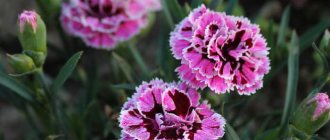Kolkwitzia charming, named after professor botanist Richard Kolkwitz, is a deciduous shrub and a beautiful flowering tree. Botanists attribute this magnificence to the honeysuckle family, and gardeners dream of planting this Chinese miracle in their garden. The central region of China is the natural habitat of this plant. Landscape designers in many countries with temperate climates actively use the decorative properties of this crop to decorate the garden.
Description of the collection
In its natural habitat, kolkvitsia grows to a height of three meters, and in the European part of Russia no more than 2 meters, and is a type of shrub. The branches grow in large increments with densely drooping hairs. The bark of old trunks has a red-brown color and peels off like honeysuckle. Bright green oval-shaped leaves (oppositely paired, 3.5-8 cm long) turn yellow in autumn.
It blooms profusely, covering the entire bush in the shape of a ball, with pinkish, bell-shaped inflorescences with five petals. The buds look very attractive and attract attention. Because of such luxurious blooming of flowers, it is impossible to even see the foliage, and such a philharmonic continues throughout the spring and covers part of the summer.
Content
- Decorative qualities
- Planting and care Placement
- Landing
- Top dressing
- Trimming
- Shelter for the winter
Kurt Stüber / Personal archive
If you want to plant an easy-to-care-for shrub on your property that blooms beautifully in the spring, then you simply need a kolkvitsia . This densely branched deciduous shrub in its natural environment reaches a height of 3.5 m. The genus is represented by a single species - the charming colquitia , growing in the mountains of the central regions of China.
The plant is distinguished by relatively high frost resistance and successfully withstands the sometimes harsh winters of mid-latitudes , but is inferior in size to its wild relatives and does not exceed 2 m in height. Also, after severe cold, flowering may be delayed (shifted to June-July).
Colquitia is easy to grow , since it does not have any special requirements for soil.
Gertrud K. / Flickr.com
Varieties of kolkvitsia
In the Russian zone, only two species are known:
- Rosea;
- Pink cloud.
Rosea is the most popular variety among gardeners in the country. At the moment of blooming, the flower stalks have a bright pink hue, but as they bloom, the inflorescences become white. They look spectacular in compositions with bushes of rich emerald green leaves. In autumn, the foliage turns a bright orange color. The throat of the flower has an orange-yellow stripe. The shrub requires careful care and crown formation.
Pink cloud (Pink-Ckoyd), literally translated, sounds like pink clouds; when grown in southern regions with warm climates, in temperate zones they grow up to 1.5 meters, both in height and in diameter. One of the most common varieties in Russia is Pink Clouds. The bush is resistant to both drought and frost. The shoots branch well and form easily.
There are no significant differences between the plants in terms of the characteristics belonging to each variety. They mainly differ in the saturation of the color scheme and the size of the petals. Throughout the first half of June, when all other ornamental shrubs have already stopped blooming, this plant continues to smell sweet and bloom.
Decorative qualities
- The drooping stems of the plant bloom profusely every year, usually in May-June. Delicate pink bell flowers densely cover almost the entire bush. They appear at the ends of the shoots in such numbers that they practically hide the foliage underneath . And this is the most important advantage of colquitia, with the help of which it has gained popularity among gardeners.
- Colquitia and its foliage are decorative , especially in autumn. Different parts of the bush are painted in different warm autumn tones . After the flowering plant fades, it gives way to other shrubs that will bloom to replace it, but will remain an excellent background for them, as well as for other flowering garden perennials.
- Several cultivated varieties of this plant have been developed. ' Pink Cloud ' variety is interesting . The bright pink airy cloud of its flowers will attract attention from afar and will arouse admiration from anyone.
Wilhelm Zimmerling / Personal archive
Planting colquitia in open ground
When choosing a place to plant in the ground, it is important to take into account that the plant is light-loving, although if there is a slight shadow, it will tolerate it well. Fertile soil with moderate moisture is what the kolkvitsia needs for growth and development. The area where the bush will grow must be protected from cold winds. Despite the fact that the plant can withstand frost down to -30 °C, after very cold winters, young shoots are partially damaged.
Planting in open ground is carried out in the spring in well-warmed soil, when the threat of return frosts has passed. If the site sits in water for a long time in the spring, then it is absolutely not suitable for this plant.
It is better to prepare the planting hole in advance about 14 days before planting in open ground, the soil in it will compact and settle. The hole should be at least 40 cm deep and 50 to 60 cm wide. Prepare the soil mixture as follows: sand, turf, humus, in the proportion (1: 2: 2). Fill the hole with a thoroughly mixed mixture and after 14 days add 80-130 g of complex fertilizer or half a bucket of ash to the soil and plant the seedling.
According to the age of the bush, it is advisable to be 1-year-old or 2-year-old for successful survival. Water thoroughly immediately after planting and cover with mulch, preferably coconut shavings.
The bush can bloom for the first time already in the second year after planting in open ground.
Kolkwitzia Pink Cloud: planting and care, cultivation
Colquitia, part of the Honeysuckle family, is characterized as a monotypic flowering crop. In its natural habitat it is found in China and only in mountainous areas. Colquitia charming Pink Cloud is a varietal representative of a deciduous shrub that is suitable for ornamental gardening in temperate climates.
Description of the lovely Pink Cloud collection
A perennial, beautifully flowering, deciduous plant, Colquitia Pink Cloud (pink cloud) decorates European botanical gardens. In Russia, they grow lovely kolkvitia from the European part to the South. The plant feels comfortable in temperate climates.
Cultivar Pink Cloud is a variety with high frost resistance. Resists temperatures down to -28 0C.
Freezing of young shoots is often observed, but this negative factor does not affect the abundance of flowering; kolkvitsia completely forms the replacement until budding.
Every year up to 4 years, the plant increases in height and width within 30 cm. When the maximum height of 1.8-2.2 m is reached, the growth stops, the growing season is aimed at budding and the formation of shoots.
Description of the habitus of the lovely Pink Cloud:
- A spreading shrub with a dense crown formed by numerous thin, drooping shoots. Old stems are dark red, rough, with partially peeling bark. The shoots of the current season are a shade lighter than the perennial ones, their surface is densely covered with fine hair.
- The leaves are of different lengths from 4 to 8.5 cm. The largest are formed at the beginning of the branches, the size decreases towards the top. The plate is in the shape of a narrow elongated oval with a sharp tip. They grow oppositely, in pairs. In spring and summer the color is dark green, in October it is bright yellow with an orange tint.
- The roots are of a mixed type, central deep, superficial fibrous. The accessory buds of the root system produce numerous shoots.
- The fruits are dry, the surface is finely bristly, small in size with two seeds. Ripen in early autumn.
After opening the seed pod, the planting material scatters and germinates the following spring.
Important! The seedlings fully correspond to the characteristics of the parent bush and are suitable for subsequent propagation.
The decorative effect of the Pink Cloud flowering plant is fully manifested only during the flowering period. The timing of budding in shrubs depends on the climate.
In the South it blooms at the end of May, in the Moscow region - in early June, in Siberia 2 weeks later. The flowering period does not depend on the region; its duration is 28 days.
The flowers dry out, turn yellow, and the bush looks untidy. Therefore, the inflorescences with the tips of the shoots are cut off.
This feature of the crop is completely compensated by the flowering period. The shrub is completely covered with numerous corymbose inflorescences. The flowers are bell-shaped, five-petaled, light pink on the outside, orange on the inside in the throat area with yellow longitudinal stripes, fragrant. The photo shows the lovely Pink Cloud at the peak of flowering.
The beautifully flowering shrub is used in ornamental gardening as a tapeworm, included in compositions with dwarf conifers, and grown to create an unshaped hedge.
Features of reproduction
According to reviews from gardeners, there are no problems with the reproduction of Pink Cloud colquitia. The seedlings quickly form a root system and take root well on the site.
An adult plant calmly reacts to the transfer; many gardeners practice the method of dividing the bush for propagation. This method is inconvenient because a plant no younger than 6 years old is suitable for division.
It can be propagated generatively; the disadvantage of this method is the unsatisfactory germination of seeds. Vegetative propagation is most often used: cuttings and layering.
Advice! The fastest and most productive way to propagate colquitia is by root shoots.
Normal vegetation of Pink Cloud colquitia depends on proper planting and subsequent care. The plant tolerates frost well, which cannot be said about the crop’s drought resistance; the plant cannot go without watering for a long time. In a constantly exposed area, the leaves burn and turn yellow. To ensure full flowering, the kolkvitsia is fed.
Recommended timing
The plant overwinters well and takes root quickly. Kolkwitzia Pink Cloud is planted on the site in spring and autumn: in the South - at the end of April, in a temperate climate, depending on regional weather conditions.
You can start working after the soil has warmed up to +12 0C, if there is no threat of frost. In autumn, in warm regions, kolkvitsia is planted in mid-September.
In areas with a cold climate, the timing is calculated so that there are 2 months left before frost.
Site selection and soil preparation
The lovely Pink Cloud columbine grows on any soil composition, the main thing is that the soil is light, fertile, with satisfactory aeration. Lowlands with stagnant moisture and areas with close groundwater are not suitable for collection. The area should be partially shaded. The crown of tall crops will protect from burns and from the north wind.
The place allocated for the Pink Cloud plant is dug up and the weeds are removed. Prepare a fertile mixture consisting of compost, sand, peat, taken in the same volume.
Landing algorithm
The root of Kolkvitia charming is treated with an antifungal agent and placed in a growth stimulator. Use medications according to instructions. Dig a hole with a diameter and depth of 65 cm.
Landing:
- The bottom is covered with a drainage cushion.
- Pour part of the nutrient mixture on top.
- The colquitia seedling is placed in the center and the roots are evenly distributed.
- Pour out the rest of the prepared soil and compact it.
- Water and mulch.
To prevent root rot, the neck is left above the surface (about 3 cm above the ground).
Features of cultivation
According to gardeners, the agricultural technology of the lovely Pink Cloud is no more difficult than growing any beautiful flowering shrub. The decorative effect of the plant depends on timely feeding, watering and cosmetic pruning. The plant is frost-resistant, but measures taken in the fall will protect the crop from unnecessary stress.
Watering and fertilizing
The watering regime for Pink Cloud columbine depends on seasonal precipitation; waterlogging of the soil will have a worse effect on the shrub than drying out of the top layer of soil. If it rains once a week, the plant is not watered. During drought, water at the time of bud formation and during the main flowering.
Feeding is given to the lovely Pink Cloud kolkvitia three times during the growing season:
- in early spring, after the buds have swollen, urea is scattered around the perimeter of the root circle;
- during budding, superphosphate is added;
- After flowering, water the roots with an organic solution.
Fertilizing is carried out in the second year after planting and all subsequent years.
Mulching
Mulch Pink Cloud flowers immediately after planting, using sawdust mixed with peat, pine needles, tree bark or wood chips.
The covering layer is multifunctional: it retains moisture, prevents weeds from growing, and protects the root from overheating in summer and hypothermia in winter.
In the fall, the mulch layer is increased, and in the spring it is completely renewed. This measure will save the gardener from constant weeding and give the site an aesthetic appearance.
Trimming
Pleasant Colquitia Pink Cloud forms inflorescences on last year's shoots; this feature of the plant is taken into account during pruning.
After flowering, the tops of the stems are cut off along with the dry inflorescences; the shoots of the current year are not touched; flowers will appear on them next season. At the same time, weak, twisted stems and several old branches are removed.
In the spring, before sap flow, sanitary cleaning is carried out, dry and frozen areas are removed.
Preparing for winter
Prepare Pink Cloud cultivars for winter 2 weeks before the onset of frost. Sequence of work:
- Water the bush with plenty of water.
- Increase the layer of mulch, and you can sprinkle dry leaves on top.
- The branches are tied into a bundle with twine.
- The top is wrapped with spunbond.
- The seedlings can be covered with spruce branches on top.
In the South, a layer of mulch is sufficient for overwintering colquitia.
Pests and diseases
Pink Cloud does not get sick; the only problem that arises when the soil is waterlogged is root rot. Watering is reduced or the kolkvitsia is transplanted to a dry area.
Parasitic insects and means to combat them are presented in the table.
| Pests | Drugs |
| Thrips | "Aster" |
| Aphid | "Fitoverm" |
| leaf roller | "Inta-Vira" |
| Shchitovka | "Aktellik" |
| Type of ticks | "Kleschevit" |
For preventive purposes in the spring, before the leaves appear, the plant is treated with copper sulfate.
Conclusion
Colquitia charming Pink Cloud is an ornamental shrub. The perennial blooms densely in early June with pink flowers. The frost-resistant plant is used in the landscape design of household plots and summer cottages; it is found in botanical and private gardens. The culture is undemanding in terms of soil composition and care. Easy to propagate, takes root well.
Reviews
Raisa Pavlova, 39 years old, St. Petersburg
At my summer cottage, the lovely Pink Cloud appeared by chance. I broke off a shoot during flowering from a friend’s columbine bush. I planted it near a dwarf pine. I mulched the conifer for the winter and covered the cuttings. In the spring, the kolkvitsia sprouted, I transplanted it. For the fourth year now, the voluminous shrub has been blooming profusely and does not create any maintenance problems.
Zinaida Sotnikova, 43 years old, Krasnoyarsk region
I am a fan of beautiful flowering shrubs, but in our climate not all plants take root. Collection Pink Cloud was an exception. I brought the seedling from Rostov, the hope that it would take root was minimal. The bush took root and bloomed in the third year. The flowers are bright with a tart smell, vaguely reminiscent of coniferous.
Source: https://fermilon.ru/sad-i-ogorod/dekorativnye-kustarniki/kolkvitsiya-prelestnaya-pink-klaud-pink-sloud-morozostoykost-otzyvy-foto-opisanie.html
Caring for colquitia in the garden
Successful growth and flowering depend on proper care. It is always important to maintain soil moisture around the tree trunk, and water only with warm water.
For good growth and development, the plant must be fed. These can be infusions of fresh manure in a ratio of 1:10, and at the beginning of summer they add double superphosphate 30-50 g per 10 liters of water per bush.
When flowering ends, they stop fertilizing the flowering plant so that new shoots do not grow, since they will not have time to ripen. At this time, formative pruning is performed. It is necessary to trim the bush after the final ripening of the fruits, and all young shoots are removed.
In early spring, a sanitary pruning is done, cutting off all branches and stems damaged by frost and pests. If there is a need to transplant the bush to a new place, then the survival rate will be high at this time. In the fall, when preparing the bush for winter, it is mulched well again and covered with pine spruce branches to prevent rodents.
Application in landscape design
Colquitia looks amazing when planted alone near a fence, near the wall of a house, or as a hedge. In order to appear in all its glory, it needs space. It is good as a tapeworm in a flower bed, surrounded by irises and peonies. It is no less magnificent on an alpine hill, in a rock garden, in combination with natural stones.
The shrub will help create a bright accent on a well-groomed green lawn or a short-trimmed lawn. In this case, balls and other unusual shapes are formed from it by trimming.
Kolkvitsia, in combination with other shrubs, for example, weigela, will help to beautifully decorate the main alley, the central entrance to the garden, to the garden area, to add decorativeness and privacy to a gazebo or garden bench.
At the end of the flowering period, the flowering plant becomes less noticeable and less decorative. Therefore, it is often combined with roses of remontant varieties that bloom all summer. In this case, it acts as a wonderful background, emphasizing their beauty.
Reproduction of Colquitia
The plant is propagated as follows:
- Generative method (seeds);
- Vegetative method (layering, cuttings, dividing the bush).
Generative method
The process is long-term and not always successful. The germination of the seeds is poor; this is hampered by a hard shell with hard protrusions. In order to destroy it, thoroughly rub it with sand or keep it in concentrated sulfuric acid for several minutes. To increase germination, they must be stratified in the refrigerator on the shelf where vegetables are stored for 3 months. After this time, in April, they are sown somewhere in long containers with a good substrate: peat, sand, turf, humus. The seeds are not very large and it is not recommended to plant them deep into the soil. A temperature of +20...22 °C is just right for germination. A pot of kolkvitsia is watered abundantly, covered with film, and kept warm. In indoor conditions it will grow until next spring.
Reproduction by layering
The most effective and reliable way. Having selected the desired shoot, it is bent into a dug groove, a small incision is made, treated with Kornevin to stimulate root growth and sprinkled. After rooting, they are transplanted into prepared holes next spring.
Cuttings
They propagate both in spring and autumn. True, the autumn one turns out to be of better quality. Selected cuttings are cut and wrapped in film, and then put away in the basement until spring, or coated with Kornevin and planted in a greenhouse or in pots for indoor germination. After 2 years they can be planted in open ground. Cuttings wrapped in a plastic bag can also be stored in the refrigerator on a vegetable shelf until germination.
Dividing the bush
You can use this method of propagation, such as dividing a bush, if you transplant the entire seedling. The bush is removed from the ground and inspected, removing rotten roots, then divided into parts, taking into account that each gets a powerful root and a developed stem. The cut areas must be covered with coal to avoid the entry of microbes and rotting of the roots. The bushes prepared in this way are planted in trenches or holes.
The first years after planting the plants, while they are still young and their branches are not mature enough, the bark is susceptible to the destructive effects of frost; they must be covered before winter with spunbond or lutrasil.
How does kolkvitia propagate by seeds?
Growing colkvitia from seeds Photos of seedlings
Seeds should be planted in the ground before winter, but you can also plant seedlings in a greenhouse in the spring.
When planting in spring at the end of March, cold stratification is carried out for 2 months.
To do this, the seeds must be stored in the refrigerator (stage 1: two weeks in the freezer, stage 2: on the refrigerator shelf).
Then the seeds are sown in large containers or in separate pots to a depth of one cm. They are grown in a greenhouse and planted in the ground in the spring of next year.
Diseases and pests
Colquitia is quite resistant to the invasion of various pests. But in hot weather it can be attacked.
The honeysuckle aphid can cause great damage to plants; young leaves and shoots dry out and fall off. If such pests are detected, they are immediately destroyed with drugs such as: Aktara, Aktelik, Fufanon. Spraying should be carried out twice, three times with an interval of 7 days. Since the first treatment kills adult insects, but the eggs remain undamaged, the subsequent treatment will destroy them too.
But not only aphids, but also the fingerwing caterpillar, which gnaws the berries, as well as the leaf beetle can harm the decorative appearance of the plant.
If the number of pests is small, they are collected by hand, and if the damage is severe, they can be sprayed with Biotkin, Herold or any other effective preparation. The greatest damage can be caused by the scale insect, which can destroy the bush completely.
Viruses and fungi can cause irreparable harm to colicweed; if it is a bacterial disease, then such a plant cannot be treated. It is dug up and burned.
If these are just microscopic fungi that damage the foliage, and are visible in the form of various spots, and they fall off the branches, then this disease is treated - chlorosis. The drugs Fosporin and copper sulfate will successfully cope with this problem.
Features of transplantation
Transplanting a columbine is a fairly simple matter, and for the plant itself this process is not stressful. To move the bush to another place, it must be carefully dug up, carefully protecting the roots from damage. The recess is dug and prepared in advance, and the dug seedling is placed in it.
Provide the plant with abundant watering as quickly as possible after planting. After waiting for the soil near the trunk to completely dry, it is necessary to mulch.
Mister summer resident informs; Features of planting columbine in the Moscow region
Kolkvitsi seedlings also grow in the temperate climate of the Moscow region. Of course, soil plays an important role in the formation of a bush. Loose, nutritious soil is the key to the success of the rapid growth of colquitia and the formation of peduncles. During the dry period, the soil is moistened, and to retain moisture, a thick layer of mulch is laid, it is good if it is peat and compost, and pine bark on top.
After watering, the bark wood will be saturated with moisture, and if a dry period occurs, it will not allow the roots to dry out. In the Moscow region, it is imperative to protect the bush from severe frosts, so that during cold, snowless winters the plant is covered as much as possible, directly affecting the young seedlings. It is necessary to cover not only the crown, but also the root system, this is especially important in snowless winters.
The lovely Colquitia is pleasant in its beauty of an airy pink cloud. With proper care, after 6-7 years, a beautiful and lush tree will form, with spreading branches in the shape of a ball.
Having planted this beautiful bush in a country house, at the dacha you can count on its gorgeous flowering and summer aroma with brightly colored autumn foliage.
Trimming
Avoid heavy pruning. To form a crown, it is enough to cut off only the old branches, without touching the side and top ones.
For rejuvenation, pruning should be done after flowering. This pruning stimulates the growth of new branches.
In spring, old branches are cut off.
The shrub is especially beautiful in autumn, when the leaves acquire a very pleasant and light golden hue.
Care
Description of the main features of care:
- Kolkvitsia is a drought-resistant crop, but still needs watering in the hot summer. It is advisable to water in the evening. Water for irrigation needs to be slightly heated;
- From the beginning of the growing season until the end of flowering, it is recommended to add mineral and organic supplements. Manure and compost are suitable as organic matter. If the plant develops poorly, then it is also necessary to feed the crop several times a season with liquid fertilizers, for example, mullein infusion;
- Getting carried away with fertilizing is undesirable, as this will lead to poor flowering, as well as a decrease in resistance to frost;
- At the end of spring, it is recommended to mulch the soil around the trunk. Peat, wood chips, and crushed bark are used as mulch. It is necessary to re-mulch the soil in the fall;
- The culture is calm about transplantation; you just need to choose the right place;
- Before the onset of winter, it is recommended to bend the young shoots to the ground and cover them with spruce branches. You can put snow on top in winter. You can also cover the crown with non-woven material. Around mid-April, the shelter can be removed. With age, the frost resistance of the shrub increases.
Pink flowers of kolkvitsia combine amazingly with irises.










